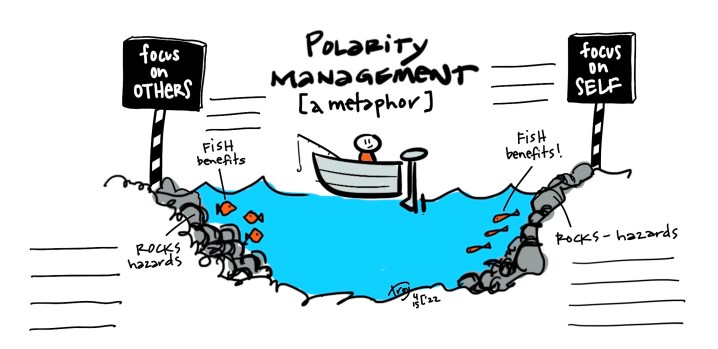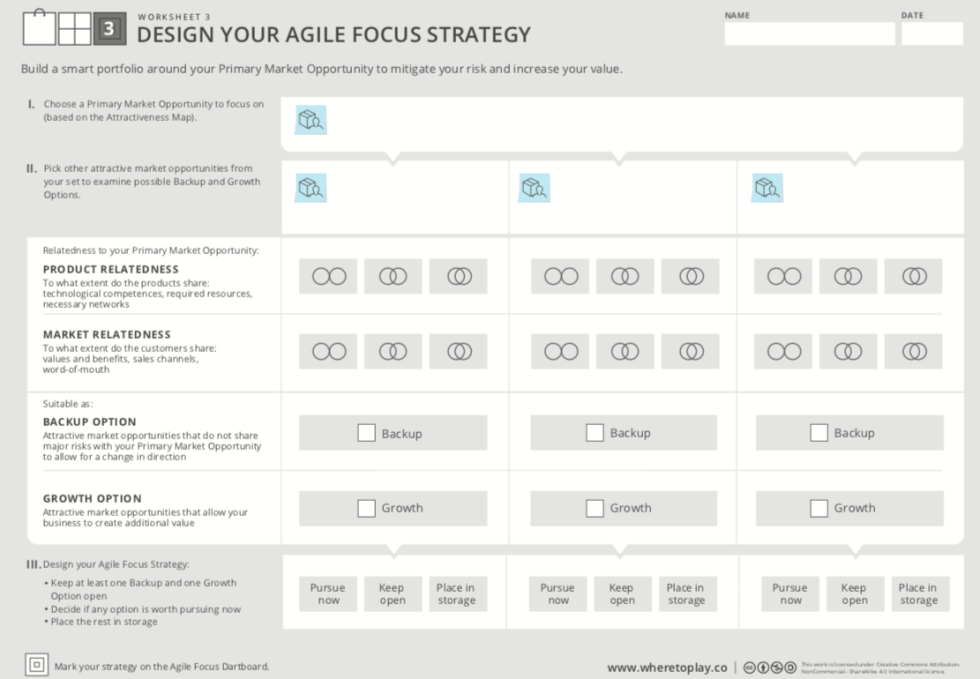Polarities live as interdependent pairs that need each other to exist, for example inhaling & exhaling. One pole is not valued as better than the other. Polarities have an enduring quality, they are unavoidable and unsolvable. Polarities live everywhere from our internal dialogue to external patterns of relating in society and within organizations. Overfocus on any one pole leads to the breakdown of the system as a whole.
Object of play
Simplify complex problems by identifying underlying patterns of tension in the system called polarities. Striking a dynamic balance between seemingly competitive forces – accomplished by observing and analyzing the paradox with a BOTH/AND lens – unlocks benefits otherwise concealed by the system.
Number of players
1-20
Invite players who are part of the system you would like to study. This game can be played as an individual examining one’s internal landscape or external environment, or invite players from across your project team or larger organization.

Duration of play
1 – 4 hours
Material required
To run a good session, you will need:
- A copy of the template
- An A4 (8.5”x11”) copy of the template for each player, or
- an A0 size copy of the template for the room, or
- a digital copy of the template, or
- each player may hand draw their own
- Pens and markers
- Post-it notes
- Camera to capture the results
An example of Even Flow facilitated virtually. Zoom in to see the flow.
How to Play
Step 1: Become aware
- Tell the players that we’re going to explore states-of-being or actions that appear to be opposites of one another.
- Ask the players to take a few minutes and silently brainstorm perceived states-of-being or actions, and their opposites. For example: inhaling and exhaling, chaotic office environment and one that’s more structured, an organization that prides itself on innovation but also needs optimization, winter and summer, individual needs vs. those of the community. These opposites might come from personal reflection, or professional experience.
- For additional examples to share, visit https://assessmypolarities.com/
- Ask the players to make a copy of the template for their personal use – draw it or copy/paste it, depending where you are.
- Ask the players to select one pair of opposites to continue with and and place one polarity on each of the sign posts in our framework. Consider using a Dot Vote.
Step 2: Map the system
- Ask the players to take a few minutes to identify the benefits and desired results that might be available through focusing on a particular pole. They can write these on the diagram or use post-it notes (one per thought). Have each player present their post-its to the group.
- Repeat for the other pole
- Ask the players to take a few minutes to identify the negative consequences that result in overfocusing on a particular pole to the neglect of the opposite pole. They can write these on the diagram or use post-it notes (one per thought). Have each player present their post-its to the group.
- Repeat for the other pole
Step 3: Tune in
Assess the current state of the system. Tune into the flow of energy between the poles.
- Ask the players to label their template by answering the following question and using one thought per post-it note:
- What are you experiencing right now in relationship to either of these poles?
- Determine your location on the spatial continuum between the poles.
- What benefits are you seeing?
- Are there any indications that negative consequences are emerging?
- Ask the players to present their thoughts to the group.
- Remind the group that overfocusing on a particular pole will lead to negative outcomes – avoid the rocks near the shore. Focus on a pole to realize the benefits – catch some lovely fish! But remember that overfishing has consequences.
- As the players to identify which benefits and hazards are alive in the system by highlighting them. Use both qualitative and quantitative data to guide your responses.
Step 4: Honor the energy
Let the results of the assessment guide behavior and decision-making. Reduce focus if early signs of negative outcomes emerge. Move in the other direction.
- Ask the players to take a few minutes to individually brainstorm what action steps might optimize benefits and reduce risks. What they might Start, Stop or Continue doing? One thought per post-it note.
- Have each player present their thoughts to the group.
Step 5: Map the future
Use the framework to guide you through future situations that arise within the tension of the polarity.
- Set up a monitoring cadence to revisit and reassess the direction of the system.
Strategy
It’s common to view polarities through an EITHER / OR lens, but this methodology works through a BOTH / AND lens (i.e. you need both INHALE and EXHALE). Critical pieces of the strategy include accurately defining the polarities and ensuring that poles are value-neutral. A breakdown in the system occurs when one pole is devalued and our energy rushes toward the preferred pole.
In organizations and teams, course corrections may take time to manifest. Make changes proportionate to the signals received. Don’t oversteer by making dramatic or violent changes toward the opposite pole when negative outcomes are observed.
Ideally, keep the map visible in the environment. Communication that includes these visual mapping references will help reinforce the strategy and thinking.
Complementary Games
Friend or Foe – organizational design analysis
Who do – identify what you need from each of your stakeholders
Empathy Map – get inside their heads to understand their pains and gains
Source
Game inspired by Barry Johnson, Polarity Partnerships: https://www.polaritypartnerships.com/
Visual Metaphor by Troy Schubert












 and reach agreement. Then placeeach market opportunity (using colored sticky notes) in the mid part of the Market Opportunity Navigator. Your Attractiveness Map is now ready.
and reach agreement. Then placeeach market opportunity (using colored sticky notes) in the mid part of the Market Opportunity Navigator. Your Attractiveness Map is now ready.
 options open will influence the technology you are developing, the patents you write, the marketing messages you choose etc.
options open will influence the technology you are developing, the patents you write, the marketing messages you choose etc.
